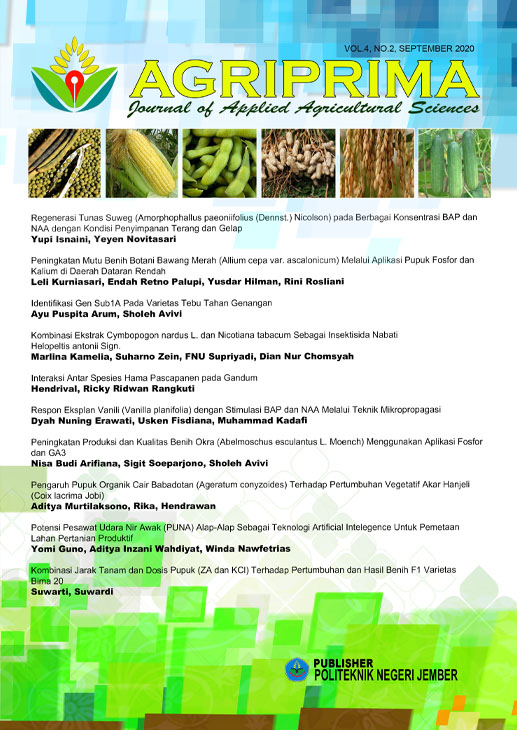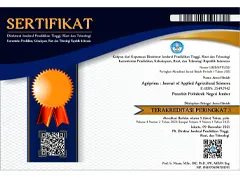Abstract
Sitophilus oryzae L., Rhyzoperta dominica (F.), dan Tribolium castaneum (Herbst) merupakan hama pascapanen yang berasosiasi dengan gandum selama penyimpanan. Interaksi antar individu dari ketiga spesies tersebut dapat mempengaruhi populasi dan kerusakan gandum. Penelitian bertujuan mempelajari interaksi antara spesies hama pascapanen terhadap populasi dan kerusakan gandum. Penelitian menggunakan Rancangan Acak Lengkap dengan perlakuan interaksi intraspesifik dan interspesifik spesies hama pascapanen. Sebanyak 30 imago diinfestasikan ke dalam stoples plastik yang berisikan 150 g gandum dengan mengikuti kombinasi berikut 30 imago S. oryzae, 30 imago R. dominica, 30 imago T. castaneum, 15 imago S. oryzae + 15 imago R. dominica, 15 imago S. oryzae + 15 imago T. castaneum, 15 imago R. dominica + 15 imago T. castaneum, 10 imago S. oryzae + 10 imago R. dominica + 10 imago T. castaneum. Parameter pengamatan meliputi jumlah imago dan persentase susut berat. Data hasil pengamatan dianalisis dengan analisis ragam. Hasil penelitian menunjukkan bahwa kompetisi interspesifik antara spesies S. oryzae, R. dominica, dan T. castaneum secara nyata dapat mengurangi populasi ketiga spesies tersebut. Kompetisi intraspesifik antara spesies hama spesies S. oryzae, R. dominica, dan T. castaneum tidak mengurangi pertumbuhan populasi, namun dapat meningkatkan kerusakan gandum. Kerusakan gandum lebih banyak terjadi pada kompetisi intraspesifik antar individu S. oryzae dibandingkan antar R. dominica atau T. castaneum. Pengetahuan tentang asosiasi antar spesies S. oryzae, R. dominica, dan T. castaneum sebagai acuan kegiatan pemantauan untuk mengevaluasi tindakan pengendalian yang dilakukan terhadap hama tersebut di penyimpanan gandum
Keywords:
Rhyzoperta dominica Sitophilus oryzae Tribolium castaneum Gandum KompetisiReferences
Ajayi, F. A., & Rahman, S. A. (2006). Susceptibility of some staple processed meals to red flour beetle, Tribolium castaneum (Herbst)(Coleoptera: Tenebrionidae). Pakistan Journal of Biological Sciences, 9(9), 1744–1748.
Aqil, M., & Taufiq, M. (2016). Gandum: Peluang Pengembangan di Indonesia (R. H. Praptana & Hermanto, eds.). Jakarta: IAARD Press.
Arthur, F. H., Ondier, G. O., & Siebenmorgen, T. J. (2012). Impact of Rhyzopertha dominica (F.) on quality parameters of milled rice. Journal of Stored Products Research, 48, 137–142.
Ashamo, M. O. (2006). Relative susceptibility of some local and elite rice varieties to the rice weevil, Sitophilus oryzae L.(Coleoptera: Curculionidae). Journal of Food Agriculture and Environment, 4(1), 249.
Athanassiou, C. G., Kavallieratos, N. G., & Campbell, J. F. (2017). Competition of three species of Sitophilus on rice and maize. PLoS One, 12(3), e0173377.
Athanassiou, C. G., Kavallieratos, N. G., Throne, J. E., & Nakas, C. T. (2014). Competition among Species of Stored-Product Psocids (Psocoptera) in Stored Grain. PLoS ONE, 9(8), e102867.
Campbell, J. F., & Hagstrum, D. W. (2002). Patch exploitation by Tribolium castaneum: movement patterns, distribution, and oviposition. Journal of Stored Products Research, 38(1), 55–68.
Campbell, J. F., & Runnion, C. (2003). Patch exploitation by female red flour beetles, Tribolium castaneum. Journal of Insect Science, 3(1).
Edde, P. A. (2012). A review of the biology and control of Rhyzopertha dominica (F.) the lesser grain borer. Journal of Stored Products Research, 48, 1–18.
Edde, P. A., Phillips, T. W., & Toews, M. D. (2005). Responses of Rhyzopertha dominica (Coleoptera: Bostrichidae) to Its Aggregation Pheromones as Influenced by Trap Design, Trap Height, and Habitat. Environmental Entomology, 34(6), 1549–1557.
Hagstrum, D. W., Reed, C., & Kenkel, P. (1999). Management of stored wheat insect pests in the USA. Integrated Pest Management Reviews, 4(2), 127–143.
Hendrival, Hasan. (2019a). Kerentanan Relatif Tepung Sorgum terhadap Kumbang Tepung Merah (Tribolium castaneum Herbst). Agrin, 23(2), 111.
Hendrival, Hendrival, Afriani, D., & Aryani, D. S. (2019b). Susceptibility and damage cereals to infestation Rhyzopertha dominica (F.) (Coleoptera: Bostrichidae) in storage. Jurnal Agro, 6(1), 57–65.
Hendrival, Hendrival, & Melinda, L. (2017). Pengaruh Kepadatan Populasi Sitophilus oryzae (L.) terhadap Pertumbuhan Populasi dan Kerusakan Beras. Biospecies, 10(1).
Hendrival, Hendrival, & Muetia, R. (2016). Pengaruh Periode Penyimpanan Beras terhadap Pertumbuhan Populasi Sitophilus oryzae (L.) dan Kerusakan Beras. Biogenesis: Jurnal Ilmiah Biologi, 4(1), 95–101.
Hodges, R. J., Robinson, R., & Hall, D. R. (1996). Quinone contamination of dehusked rice by Tribolium castaneum (Herbst) (Coleoptera: Tenebrionidae). Journal of Stored Products Research, 32(1), 31–37.
Kayode, O. Y., Adedire, C. O., & Akinkurolere, R. O. (2014). Influence of four cereal flours on the growth of Tribolium castaneum Herbst (Coleoptera: Tenebrionidae). Ife Journal of Science, 16(3), 505–516.
Longstaff, B. C., & others. (1981). Biology of the grain pest species of the genus Sitophilus (Coleoptera: Curculionidae): a critical review. Protection Ecology, 3(2), 83–130.
Mahroof, R. M., Edde, P. A., Robertson, B., Puckette, J. A., & Phillips, T. W. (2010). Dispersal of Rhyzopertha dominica (Coleoptera: Bostrichidae) in Different Habitats. Environmental Entomology, 39(3), 930–938.
Mewis, I., & Ulrichs, C. (2001). Action of amorphous diatomaceous earth against different stages of the stored product pests Tribolium confusum, Tenebrio molitor, Sitophilus granarius and Plodia interpunctella. Journal of Stored Products Research, 37(2), 153–164.
Nansen, C., Flinn, P., Hagstrum, D., Toews, M. D., & Meikle, W. G. (2009). Interspecific associations among stored-grain beetles. Journal of Stored Products Research, 45(4), 254–260.
Phillips, T. W., & Throne, J. E. (2010). Biorational Approaches to Managing Stored-Product Insects. Annual Review of Entomology, 55(1), 375–397.
Sarwar, M. (2015). Categorization of some advanced local wheat lines Tribolium castaneum (Herbst) against (Coleoptera: Tenebrionidae). International J of Sci Engineering, 1(3), 108–113.
Sembiring, H., Hasnul, H., & Diana, D. (2016). Kebijakan pengembangan gandum di Indonesia. In Gandum: Peluang Pengembangan di Indonesia (pp. 15–26). Jakarta: IARD Press.
Shafique, M., Ahmad, M., & Chaudry, M. A. (2006). Feeding preference and development of Tribolium castaneum (Herbst.) in wheat products. Pakistan Journal of Zoology, 38(1), 27.
Srivastava, C., & Subramanian, S. (2016). Storage insect pests and their damage symptoms: an overview. Indian Journal of Entomology, 78(special), 53.
Subedi, S., GC YD, T. R. B., & Rijal, J. P. (2009). Rice weevil (Sitophilus oryzae L.) host preference of selected stored grains in Chitwan Nepal. Journal of the Institute of Agriculture and Animal Science, 30, 151–158.
Sumarno, S., & Mejaya, M. J. (2016). Pertanaman dan Produksi Gandum di Dunia. In Gandum: Peluang Pengembangan di Indonesia (pp. 1–14). Jakarta: IARD Press.
Umar, A., Shirama, U., & Turaki, J. M. (2015). Susceptibility of two maize grain flour to infestation by the rust-red flour beetle (Tribolium castaneum Herbst). J Phytopharmacol, 4, 259–262.
Vardeman, E. A., Campbell, J. F., Arthur, F. H., & Nechols, J. R. (2007). Behavior of female Rhyzopertha dominica (Coleoptera: Bostrichidae) in a mono-layer of wheat treated with diatomaceous earth. Journal of Stored Products Research, 43(3), 297–301.
Verheggen, F., Ryne, C., Olsson, P.-O. C., Arnaud, L., Lognay, G., Högberg, H.-E., … Löfstedt, C. (2007). Electrophysiological and Behavioral Activity of Secondary Metabolites in the Confused Flour Beetle, Tribolium confusum. Journal of Chemical Ecology, 33(3), 525–539.
Wagiman, F. X., SSW, P. K., & Tarmadja, S. (1999). Asosiasi Sitophilus oryzae (Col.: Curculionidae) dan Tribolium castaneum (Col.: Tenebrionidae) dalam Beras: Pertumbuhan Populasi dan Kerusakan Beras. Jurnal Perlindungan Tanaman Indonesia, 5(1), 30–34.
Weston, P. A., & Rattlingourd, P. L. (2000). Progeny Production by Tribolium castaneum (Coleoptera: Tenebrionidae) and Oryzaephilus surinamensis (Coleoptera: Silvanidae) on Maize Previously Infested by Sitotroga cerealella (Lepidoptera: Gelechiidae). Journal of Economic Entomology, 93(2), 533–536.
Zunjare, R., Hossain, F., Muthusamy, V., Jha, S. K., Kumar, P., Sekhar, J. C., … Gupta, H. S. (2016). Genetic variability among exotic and indigenous maize inbreds for resistance to stored grain weevil (Sitophilus oryzae L.) infestation. Cogent Food & Agriculture, 2(1).
License
Copyright (c) 2020 FNU Hendrival, Ricky Ridwan Rangkuti

This work is licensed under a Creative Commons Attribution-ShareAlike 4.0 International License.
You are free to:
- Share — copy and redistribute the material in any medium or format.
- Adapt — remix, transform, and build upon the material for any purpose, even commercially.
Under the following terms:
- Attribution — You must give appropriate credit, provide a link to the license, and indicate if changes were made. You may do so in any reasonable manner, but not in any way that suggests the licensor endorses you or your use.
- ShareAlike — If you remix, transform, or build upon the material, you must distribute your contributions under the same license as the original.
- No additional restrictions — You may not apply legal terms or technological measures that legally restrict others from doing anything the license permits.









